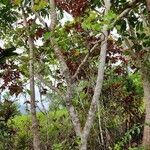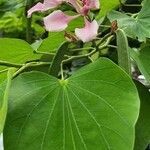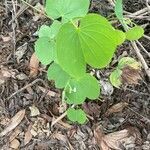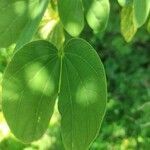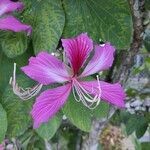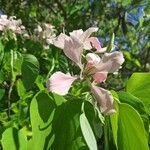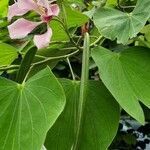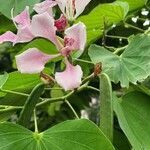Deciduous shrub or tree to 7.5 m high. Bark smooth, grey. Stems rusty-pubescent, glabrescent. Leaves: stipules 6–7 mm long, attenuate; petiole 4–6 cm long; lamina broadly ovate to rounded, 7–15 cm long and wide, divided into acute or rounded lobes; veins pubescent below. Flowers in short racemes; pedicels 2.7–4 mm long, puberulous. Calyx 15–22 mm long, pubescent. Petals ± ovate, 45–50 mm long; 4 lower ones cream with deep red markings, turning pink-lilac; upper petal yellow with crimson speckling; claws loosely hirsute at base. Perfect stamen 1; filaments loosely hirsute; staminodes c. 3 mm long. Pistil exceeding stamens. Pod narrowly oblong, thick, raised over seeds, to 22 cm long, 2–3 cm wide, puberulous, smooth or obliquely wrinkled on side opposite suture, brown. Seeds 10–20, c. 10 mm long, flat, black, shining.
Small cultivated tree with young branches lightly pubescent. Leaves ovate-orbicular, up to 20 cm. long and almost as wide, chartaceous to subcoriaceous, glabrous above, pubescent on veins below, basally cordate to truncate, apically cleft up to 1/3 the length of the leaf, lobes blunt, rounded; petiole lightly pubescent, up to 6 cm. long, with bilobate callus at insertion of the leaf. Inflorescence a terminal few-flowered raceme. Flowers large, showy; calyx about 3 cm. long,
A deciduous tree. It grows to 7 m tall and spreads to 4 m across. The stem is slender and erect. It often forms several stems. It has widely spreading branches. The leaves have 2 lobes and are yellowish-green. The flowers are pale pink with red dots and have 5 petals and one fertile stamen. Flowers are usually of one sex. They are orchid like and are 10 cm across. They occur around stalks on the end of branches. The flowers only have one stamen. Pods are 20 cm long.
spathaceous, pubescent without, tube (including pedicellar part) slender, 2-2.5 cm. long; petals obovate-oblanceolate, 4-5 cm. long, uppermost maculate; fertile stamen 1, arcuate, about 4 cm. long, other stamens rudimentary; anther linear, versatile, sagittate, about 5 mm. long; fruit reported linear, flat, up to 22 cm. long.
